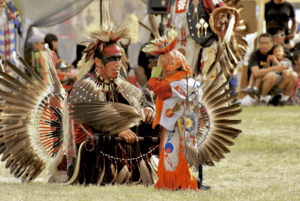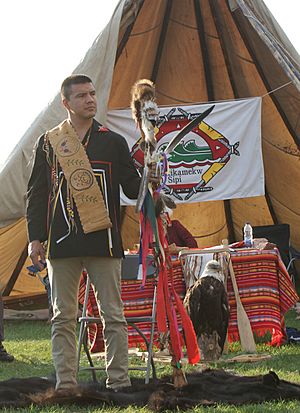Atikamekw facts for kids
 |
|
| Total population | |
|---|---|
| 8,005 | |
| Regions with significant populations | |
| Languages | |
| Atikamekw, French, English | |
| Religion | |
| Catholicism, Other | |
| Related ethnic groups | |
| Innu, Cree, other Algonquian peoples |
The Atikamekw are Indigenous people who live in a part of Quebec, Canada, that they call Nitaskinan ('Our Land'). This area is in the upper Saint-Maurice River valley, about 300 kilometers (186 miles) north of Montreal. Today, there are around 8,000 Atikamekw people. One of their main communities is Manawan.
The Atikamekw language is a type of Cree, which belongs to the Algonquian family. It is very similar to the language spoken by the Innu people. The Atikamekw language is still used every day, and it is one of the Indigenous languages that is not in danger of disappearing. However, their traditional way of life is at risk because logging companies have taken over much of their land.
The name Atikamekw means 'lake whitefish'. You might also see it spelled Atihkamekw, Attikamekw, Attikamek, or Atikamek. When French colonists first met them, they called them Têtes-de-Boules, which means 'Ball-Heads' or 'Round-Heads'. Some Atikamekw families still earn a living by making traditional items like birch bark baskets and canoes.
Contents
Atikamekw Population

The Atikamekw people live in several communities in Quebec. Here is a look at their population numbers from September 2012:
| Communities | First Nation official name | Total registered population |
Residents | Non-residents |
|---|---|---|---|---|
| Manawan | Les Atikamekw de Manawan | 2,576 | 2,197 | 379 |
| Obedjiwan | Atikamekw d'Opitciwan | 2,683 | 2,225 | 458 |
| Wemotaci | Conseil des Atikamekw de Wemotaci | 1,730 | 1,358 | 372 |
| Atikamekw (Total) | Attikamekw Sipi - Conseil de la Nation Atikamekw | 6,989 | 5,780 | 1,209 |
History of the Atikamekw
French records from the early 1600s first mention the Atikamekw. At that time, they lived in the northern forests of the Mauricie region. The French tried to write down their name as "Atikamegouékhi". Early reports described the Atikamekw as a group of 500 to 600 people, calling them "one of the more important nations of the north."
The Atikamekw got their food by fishing, hunting, and trapping animals. Women also grew and prepared foods like corn and maple syrup. Maple syrup was made by boiling sap from maple trees. Both men and women made tools from wood and animal parts, such as bones. Women made clothes from animal hides. The Atikamekw traded with other Indigenous groups nearby and even over long distances. In the summer, they would gather in places like Wemotaci. In the fall, they would get ready for winter and split into smaller groups across the forest.
When the French joined the trading networks, they brought new European goods like metal tools. The Atikamekw traded furs for these items, and they started to rely more on European goods through the fur trade. The Atikamekw were known as a peaceful people. They shared their region with the Innu to the east, the Cree to the north, and the Algonquin to the south. The Mohawk, a powerful group from the south, competed with them for beaver furs and hunting grounds.
Sadly, the Atikamekw caught new diseases from the Europeans through their Innu allies. Around 1670-1680, a smallpox sickness badly affected the Atikamekw. Many who survived the smallpox were later killed by the Mohawk during trade conflicts.
In the early 1700s, a group called "Tête-de-Boule" by the French reappeared in the region. While it is not fully clear where this group came from, they might have been a mix of the few Atikamekw survivors and other nomadic Indigenous tribes. This group eventually became known as the Atikamekw.
Today, the Atikamekw, like their historical allies the Innu, have faced problems from mercury poisoning. This happened because their water supply was polluted by power companies before there were many environmental rules.
Atikamekw Culture
The Atikamekw have their own special culture, language, and traditions. They also shared ideas with nearby peoples. Three main communities developed, all speaking the same language but with slightly different ways of speaking. Most Atikamekw people speak the Atikamekw language, but most do not write it.
Traditionally, the Atikamekw lived in dome-shaped homes called "piskokan". They made these homes with branches and covered them with bark. They put spruce branches on the floor and used furs for beds and blankets. The Atikamekw kept meat fresh by smoking and drying it. Some families still do this today. Women also gathered berries and made them into a paste that could be stored for several weeks.
Ethnobotany (Plant Uses)
The Atikamekw have a lot of knowledge about plants and how to use them. For example, they chew the sap of the Abies balsamea tree to help with colds. They also use the branches of this tree as mats for their tent floors. You can find more information about their plant uses online.
Crafts and Skills
In the past, making hunting tools like bows, snowshoes, and sleds, as well as clothes and blankets, was very important for survival. The Atikamekw created unique decorations for their clothing. They would put bells made from hollowed-out bones on their special robes.
The Atikamekw are well-known for their amazing skill in making items from birch bark, such as baskets and canoes. They decorate these items with beautiful designs. These skills have been passed down from older generations to younger ones. Because of their bark crafts, the Atikamekw are sometimes called the "people of the bark." The people of Obedjiwan make fewer birch bark crafts than other communities. This is because their area in the northern forest has more conifer trees (like pine and spruce) than birch trees.
Seasons and the Year
The Atikamekw recognize six seasons in their year, and each season has a main activity. The seasons start with Sîkon, which is late winter. During Sîkon, the Atikamekw make bark baskets and collect maple sap. After Sîkon comes Mirôskamin, which is like spring. In this season, they usually fish and hunt for partridge. These activities continue through Nîpin (Summer).
During Takwâkin (autumn), the Atikamekw hunt for moose. A successful moose hunt involves carefully removing the skin, making offerings, and preparing the meat to be preserved by smoking and drying it into "jerky." Women work to prepare the moose hides: they remove the hair, soak, clean, and tan the hide. Then they cut it into thin, flexible strips to weave nets for snowshoes. When winter begins, called Pîtcipipôn, the men trap for beaver. During the main winter season, Pipôn, the men make nets to fish under the ice, while others make snowshoes.
Along with the seasons, the Atikamekw divide the year into 12 months. The names of the months are based on the main activity or what they observe in nature during that time. The months are:
- Kenôsitc Pisimw – January: Longest [Winter] Moon
- Akokatcic Pisimw – February: Groundhog Emerges Moon
- Nikikw Pisimw – March: Otter Moon
- Kâ Wâsikatotc Pisimw – April: Reflects on the Ice Moon
- Wâpikon Pisimw – May: Flower Moon
- Otehimin Pisimw – June: Strawberry Moon
- Mikomin Pisimw – July: Raspberry Moon
- Otâtokon Pisimw – August: [Bird] Fledges Moon
- Kâkône Pisimw – September: Porcupine Mates Moon
- Namekosi Pisimw – October: Trout [Spawns] Moon
- Atikamekw Pisimw – November: Whitefish [Spawns] Moon
- Pîtcipipôn Pisimw – December: Winter Arrives Moon
Notable people
- Constant Awashish, Grand Chief of the Atikamekw Nation
- Kwena Bellemare-Boivin, actress and musician
- Rykko Bellemare, actor and musician
- Cesar Newashish, canoe maker
- Jacques Newashish, actor, artist and filmmaker
- Laura Niquay, singer-songwriter
- Eva Ottawa, former Grand Chief of the Atikamekw Nation
- André Quitich, former Grand Chief of the Atikamekw Nation
See also
 In Spanish: Atikamekw para niños
In Spanish: Atikamekw para niños


